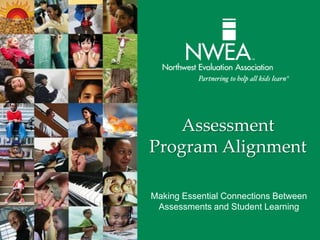
Assessment Program Alignment: Making Essential Connections Between Assessments and Student Learning
- 1. Assessment Program Alignment Making Essential Connections Between Assessments and Student Learning
- 2. Using the Right Tool 2
- 3. How familiar are these statements? We have too many assessments. We are giving assessments and interrupting our instruction all year long. We have too much data and too little time to make sense of it. We haven’t prioritized what data we are supposed to use. We have too many different opinions about which assessments are most important. We are using assessment data but don’t seem to be seeing improvement in our results. We’re frustrated that teachers don’t seem to understand their assessments. We’re frustrated our district doesn’t provide teachers with enough guidance in using assessments. With so many assessments, just analyzing the data takes all of our focus. 3
- 4. Choose a question that you connect with… How can a common understanding of assessment vocabulary support a commitment to improved student outcomes? What is the purpose of our assessments? What kind of data do our assessments generate? What do our assessments reveal about student learning? How do they support our instructional choices? What constitutes an ideal assessment program? What does it look like and sound like? What are the strengths and areas that need improved in our current system? 4
- 5. Connecting Assessments and Student Learning Consider these steps: 1. Create a shared knowledge of assessment literacy 2. Examine your assessment program for purpose, utilization, alignment and accountability 3. Examine your actions to ensure they reflect a shared vision 5
- 6. Assessment Literacy 1. Create an activity to build a common understanding of assessment vocabulary 2. Establish norms to ensure it is safe to say: a.Don’t know b.Think I should know, but I don’t c.Think I know but want to check it out d.No comment e.Think I have it 6
- 7. Assessment Literacy Activity 3. Given periodically to establish baseline assessment which give 1. A culminating data A. Benchmark and measure progress toward a standard. information on students’ mastery of Assessment Provide data about standards that have been content, knowledge or skills. mastered and which need additional instruction. 5. Assessments where individual’s performance B. Criterion- 2. Used in NRT to indicate a score below is compared to specific learning objective or Referenced performance standard and not a certain percentage falls. [Used which to performance Do we agree of other students. [student-to-standard data] to other students] to compare students Tests on the 4. Tool that assesses Given periodically to establishdefinitions? 3. student strengths baseline data C. Diagnostic and weaknesses to inform instructional toward a standard. and measure progress Assessment decisions. Usually administered instandards that have been Provide data about mastered and which need additional instruction. advance of instruction. What do I 2. Used in NRT to indicate a that assesses student strengths 4. Tool score below D. Percentile and weaknesses to inform need to know which a certain percentage falls. [Used instructional or to learn? to compare students to other students] administered in decisions. Usually advance of instruction. 5. Assessments where individual’s performance 1. A culminating assessment which give E. Summative information on students’ mastery of learning objective or is compared to specific Assessment performance standard and not to performance content, knowledge orstudents. [student-to-standard data] of other skills. 7
- 8. Examine your Assessment Program To examine your program for purpose, utilization, alignment and accountability, begin with the question: What do we believe is important about assessing for learning? 1. Self reflect 2. Examine your beliefs 8
- 9. Self Reflection 1. What is my goal in terms of understanding our assessment program? 2. What is my current reality? 3. What do I need to do to address the gap? 9
- 10. Activities to Examine Your Beliefs 10
- 11. Considering Purpose - Dig Deeper • Complete a district assessment review • Conduct a data inventory 11
- 12. Examine Your Actions • Improvement plans contain areas of focus, actions and timelines reflecting the hard work of educators. • Revisit your plans through the lens of having a shared assessment vision and prioritize actions 12
- 13. Addressing the Gaps • What competencies do we need to learn that will address gaps in reaching our assessment goals? • When we build these competencies, what practices will we see on a regular basis throughout the school? • As our practices change, what student outcomes will help us measure the affects of these changes? 13
- 14. Aligning Plans with Vision 14
- 15. Sustaining Capacity You have created a common assessment literacy You have examined your assessment program You examined your improvement plan to align actions and address gaps 15
- 16. Questions for Ongoing Dialogue Are we painting pictures of our students using multiple points of data? With what with know about assessment purpose now, how do we “weight” the information? How are we using assessment data to design specific actions we need to take? How are we supporting student growth with the data? 16
- 17. Thank you for your attention! BIE Schools: katie.redden @nwea.org AZ Schools: tracy.jones@nwea.org
